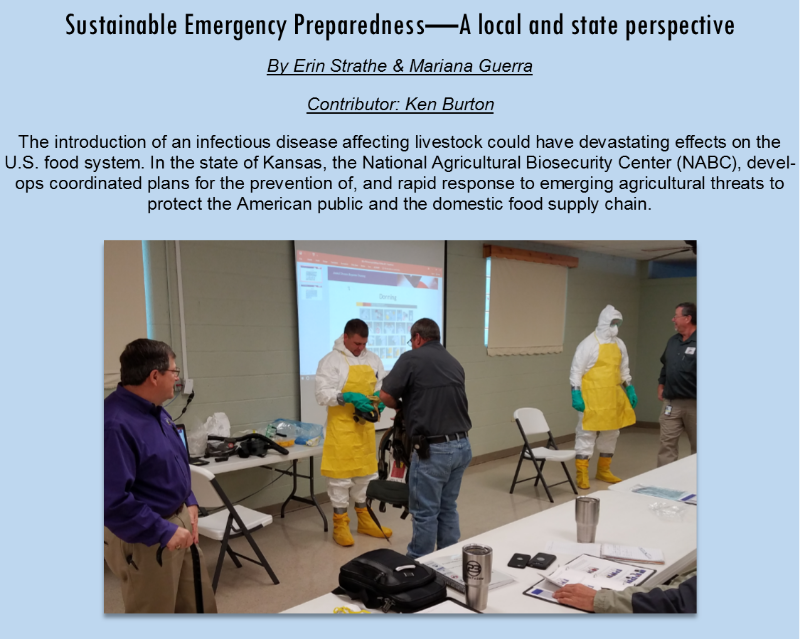Using Earth Observation Data in "One Health" Applications for Societal Benefits - Conference Proceedings
Earth observing research satellites and remote sensing technologies collect data on environmental constituents that increase our knowledge and understanding of our planet as well as our solar system. Scientists analyze and interpret these Earth observations and geospatial data to answer established research or program objectives that describe the health of the aquatic and terrestrial ecosystems and global air quality, and ultimately provide answers and solutions to the scientific questions. Indeed, through Earth observation analysis, data are used in diverse public health applications, including assessing air quality standards, forecasting infectious disease outbreaks, interpreting spatial and environmental relationships, developing and modeling systems, among others (Photo 1). "One Health"– a joint risk management approach for human-animal-environmental health nexus issues – benefits from these sorts of data streams and analyses.
Photo 1. NASA Earth Science U.S. government interagency and international partnership on-orbit missions (Credits: NASA).

One recent example that showcased the transdisciplinary collaborations among the diverse array of scientific disciplines related to environmental sciences was the Group on Earth Observations (GEO) Plenary XIV Meeting, which was held from October 23–26, 2017, in Washington, D.C. International scientists and leaders, representing multiple countries, such as Australia, Canada, China, Germany, Japan, and the United States, shared innovative strategies about using and analyzing Earth observations. They participated in various side events (e.g., Earth Observations in Service of the 2030 Agenda for Sustainable Development, GEO Global Water Sustainability and the harmonization of GEO Water Activities), networked at scientific exhibits, and attended plenary sessions (e.g., Earth Observations in Public Policy, Earth Observations in International Development, GEO Work Programme). More specifically, the two following GEO side events promoted the "One Health" approach, aiming to connect international scientists, policy makers, community stakeholders, and other end users of Earth observation data.
1. Operationalizing the "One Health" approach.
Representatives from the U.S. Environmental Protection Agency (EPA), U.S. Department of State, and National Aeronautics and Space Administration (NASA), coordinated the presentation agenda for the side event, "Operationalizing One Health: Observe, Analyze, Communicate". Over 40 audience members attended and contributed to the open discussion on three major topics: 1) an overview of the observe-analyze-communicate cycle provided insight into one strategic framework for operationalizing the "One Health" approach (Photo 2); 2) local observations, which contribute essential local, indigenous, and institutional knowledge about the environment, were presented as complementary tools to remote sensing technologies; and 3) case studies, based on real-world examples, were described in two unique settings: the Arctic-based Local Environmental Observers program and a worldwide (tropically-focused) GLOBE Observer Mosquito Habitat Mapper app. A final discussion coordinated an open dialogue about gaps and next steps, including using innovative strategies to integrate remote and local Earth observations in practice and highlighting the role of citizen science.
Photo 2. At the GEO side event, "Operationalizing One Health: Observe, Analyze, Communicate", Helena Chapman presents the overview cycle that promotes the steps of observation, analysis, and communication, which can guide using the "One Health" approach in practice.

2. Incorporating Earth observations into "One Health" applications.
Representatives from the GEO Health Community of Practice organized the meeting to bring together various international agencies and stakeholders, ranging from Earth scientists to health professionals, to address GEO Health Tasks. This meeting aimed to elaborate on the contributions of GEO Earth observations to four focus areas: 1) designing a harmful algal bloom early warning system; 2) integrating methods for air quality and health data; 3) developing a global observing system for mercury and persistent pollutants; and 4) using Earth observations for health applications. The session started with a call to action to develop a national policy framework that integrates Earth observations and population health data to address and reach the targets defined by the Sustainable Development Goals (SDGs). Then, several presenters focused on how Earth observation analysis can influence knowledge translation for a range of applications. Cases studies, including harmful algal blooms, heat extreme events, and biodiversity loss, highlighted transdisciplinary collaborations across public and private sectors. For example, satellite data can track harmful algal blooms and aid in risk assessment and decision making to protect population health (Photo 3). The session was finalized with an open discussion to identify challenges and future steps toward enhanced integration of Earth observations into science education, practice, and research
Photo 3. NASA Aqua and Terra multi-national scientific research satellites data help to see, detect, follow-up and forecast Harmful Algal Blooms (true green color in the image) in the Great Lakes (Lake Erie), and respond accordingly (Credits: NASA).

The GEO Plenary XIV Meeting served as a successful platform to facilitate channels of communication among international end users of Earth observation data. This open dialogue stimulated innovative inquiry on how to best integrate and fruitfully use remote sensing science and "One Health" approaches to attain shared global goals such as the SDGs, while also examining strategies to improve communication among stakeholders, and expand capacity-building programs that target Earth observation analysis. Success in these areas would yield important co-benefits for health education, practice, and research.
The next GEO Plenary XV Meeting will be held from October 29 to November 2, 2018, in Kyoto, Japan.
Author
Helena Chapman
OHNL Contributor and Editor
AAAS Science & Technology Policy Fellow
NASA Applied Sciences Program
helena.chapman@nasa.gov
K-State Olathe
22201 W. Innovation Dr.
Olathe, KS 66061-1304
913-541-1220
913-541-1488 fax
olatheinfo@k-state.edu